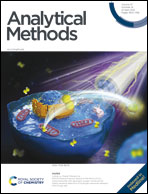A chemometric strategy for accurately identifying illegal additive compounds in health foods by using ultra-high-performance liquid chromatography coupled to high resolution mass spectrometry†
Abstract
The accurate identification of unknown illegal additive compounds in complex health foods continues to be a challenging task in routine analysis, because massive false positive results can be screened with ultra-high-performance liquid chromatography coupled to high-resolution mass spectrometry-based untargeted techniques and must be manually filtered out. To address this problem, we developed a chemometric-based strategy, in which data analysis was first performed by using XCMS, MS-DIAL, Mzmine2, and AntDAS2, to select those that provided acceptable results to extract common features (CFs), which can be detected by all of the selected methods. Then, CFs whose contents were significantly higher in the suspected illegal additive group were screened. Isotopic, adduct, and neutral loss ions were marked based on the CFs by using a new adaptive ion annotation algorithm. Fragment ions originating from the same compound were identified by using a novel fragment ion identification algorithm. Finally, a respective mass spectrum was constructed for each screened compound to benefit compound identification. The developed strategy was confirmed by using a complex Chinese health food, Goujiya tea. The features of all illegal additive compounds were precisely screened by the developed strategy, and massive false positive features from the current data analysis method were greatly reduced. The constructed respective mass spectra can benefit compound identification and avoid the risk of identifying ions from the same illegal compound as different compounds. Moreover, unknown compounds that are contained in an illegal compound library can be screened.



 Please wait while we load your content...
Please wait while we load your content...